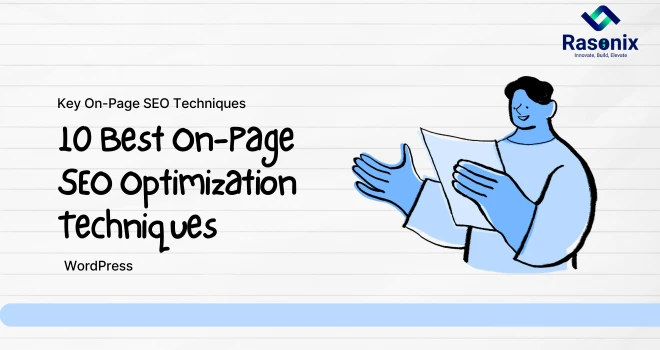In the present digital age, if you are in search of improving your visibility in the search engines using your WordPress website, then you must be able to carry out on-page SEO optimization. Off-page SEO may be important, but on-page SEO grounds your visibility, relevance, and user engagement. In this article, everything you should know about on-page SEO in web marketing, its significance, the procedures used in on-page SEO, how to take advantage of live data to streamline on-page SEO, and how to do your best to confirm will be discussed.
What is On-Page SEO Optimization?
On-page SEO optimization refers to the act of optimizing individual web pages for better ranking on search engines and more organic traffic. Activities like this include optimizing content, HTML tags, posting a blog on WordPress, and overall user experience. Off-page SEO, conversely, refers to work that provides natural link signals from a different website. On-page SEO work involves improving your own site's internal parameters. An effective keyword research strategy ensures your on-page SEO techniques align with real user queries.
Why Is On-Page SEO Important?
On-page SEO matters as it:
1. Enhances the visibility and rankings of your site.
2. Enhances the user experience and interaction.
3. Provides search engines with better comprehension and crawlers' ability to index your content.
4. Increases your organic traffic and conversion levels.
5. Aids off-page SEO efforts through the provision of good quality, shareable content.
Key On-Page SEO Techniques for WordPress

1. Optimization of Content
For on-page SEO, content is the most important thing. It must be informative, helpful, high quality and SEO and user experience optimized.
1. Keyword Optimization: Use primary and secondary keywords naturally in the article.
2. LSI Keywords: Use related words that increase content relevance.
3. Content-Length: Studies have established that long content with 1,500 plus words performs better.
4. Readability: Use simple language and shorter paragraphs for better user engagement.
5. Multimedia Components: Use images, videos, and infographics to maximize dwell time.
2. URL Structure & Site Architecture
1. A clean and well-structured URL can also help with user- and search engine-site navigation.
2. Use short, keyword-containing, descriptive URLs (e.g., yourwebsite.com/on-page-seo-guide).
3. Do not use unnecessary characters or numbers.
4. Use good internal linking to provide an intuitive site hierarchy.
3. Meta Tags Optimization
Meta tags give search engines information about the content.
1. Title Tag: Opt for 60 characters in the title and include your primary keyword.
2. Meta Description: Opt for 155-160 characters as a description, with some relevant keywords.
3. Header Tags (H1-H6): Use the heading tags to segment content into bite-sized, readable pieces, and improve SEO.
4. Image Optimization
1. Use descriptive filenames for the images (e.g., on-page-seo-checklist.png rather than image1.png).
2. Compress your images to improve page speed.
3. Also, include alt text that contains keywords to increase pictures' accessibility and image search rankings.
5. Internal & External Linking
1. Internal Links: Link your site's inner pages so users can more easily browse your site and help search engines understand your site's overall organization and content space. Internal links also help you spread link value throughout your site, which benefits SEO.
2. External Links: Internal linking is pointing to trustworthy sites, which adds credibility to your links that are driving your traffic. Linking to other websites also can add value to your readers and signal the relevancy of your content to other web content.
6. Mobile-Friendliness & Core Web Vitals
Google emphasizes mobile-first indexing, so using responsive design is a must.
1. Make sure your WordPress theme is mobile-friendly.
2. Improve UX with Core Web Vitals (Largest Contentful Paint, First Input Delay, Cumulative Layout Shift).
3. Also, make sure that your content is unique and aligns with Google’s EEAT Guidelines.
7. Page Speed Optimization
1. A slow site hurts rankings and user experience.
2. Use caching plugins like WP Rocket.
3. Optimize images and minimize HTTP requests.
4. Apply lazy loading for better performance.
8. Schema Markup Implementation
1. Schema markup helps search engines understand your content better.
2. Add structured data for FAQs, reviews, and product pages.
3. Validate markup using Google's Structured Data Testing Tool.
9. SSL Certificate & Secure Browsing (HTTPS)
Google prefers secure sites. Ensure your WordPress site has an SSL certificate activated.
10. Technical On-Page SEO Factors
1. Robots.txt & XML Sitemap: Help search engines crawl and index your site properly.
2. Canonical Tags: Prevent duplicate content issues.
3. 404 Error Handling: Implement proper redirects for broken links.
On-Page vs. Off-Page SEO: What's the Difference?
| Aspect |
On-Page Optimization |
Off-Page Optimization |
| Definition |
The method of enhancing individual web pages to increase rankings and user experience. |
Methods done off of the website to enhance domain authority and ranking. |
| Focus |
Enhancing the content, structure, and HTML components directly on the site. |
Enhancing authority, trust, and popularity on factors external to the website. |
| Key Elements |
Title tags, meta descriptions, keyword optimization, internal linking, content richness, image optimization, URL structure, and mobile friendliness. |
Backlinks, social media engagement, guest blogging, influencer marketing, brand mentions, and directory listings. |
| Control |
Website owners have full control over on-page SEO elements. |
Website owners have no control over off-page SEO operations. |
| Goal |
Ensuring the website is friendly to search engine rankings and enhances user experience. |
Increasing a website's credibility, domain authority, and external recognition. |
| Examples |
Writing quality content with keywords.
- Improving the speed of the site.
- Marking up the content with structured data (schema markup). |
Getting backlinks from authoritative websites.
- Social media shares and promotions.
- Listing your business in directories. |
| Impact on Rankings |
Has a direct impact on rankings in that search engines look at page content and page structure. |
Has an indirect impact on rankings by increasing your website's credibility and how trustworthy it is. |
Conclusion
Obtaining a comprehensive understanding of on-page SEO optimization is key to improving your search engine rankings and increasing more organic traffic to your WordPress website. There are several variables that come into play, from keyword research and content optimization to technical SEO and mobile optimization. All these contribute a bigger role towards making value and eventually a sound digital presence. If you implement the suggestions in this guide, your site visibility and user interaction will be boosted, and you will overshadow millions of competitors.
Time to Power Your Website! Call Rasonix!
Rasonix is a company that deals with on-page SEO and off-page SEO optimization to rank better and have a flawless user experience. If you need WordPress SEO expertise, technical SEO, and tailored digital marketing, you are in the right company.
Why Rasonix?
1. Proven SEO skills with WordPress websites.
2. Data and analytics tuned.
3. Solutions created for small, medium, and large businesses.
4. Transparency in reporting and measurable results
Contact Us Today! Let's Optimize Your Site! Call us today for a free consultation to boost rankings and traffic on your site!
Frequently Asked Question on On-Page SEO Optimization:
1. What is WordPress on-page SEO optimization?
On-page SEO optimization refers to the process of optimizing a WordPress website's content, structure, and HTML elements to rank higher in search engines.
2. How do you optimize a page for search engine optimization?
1. Do keyword research.
2. Optimize title tags, meta descriptions, and content.
3. Improve site speed and mobile-friendliness.
4. Include structured data and internal linking.
3. What are the best on-page SEO practices?
1. Developing high-quality, keyword-optimized content.
2. Using proper heading structures.
3. Improving user experience and site navigation.
4. Mobile device optimization.



















 Subscribe Now
Subscribe Now